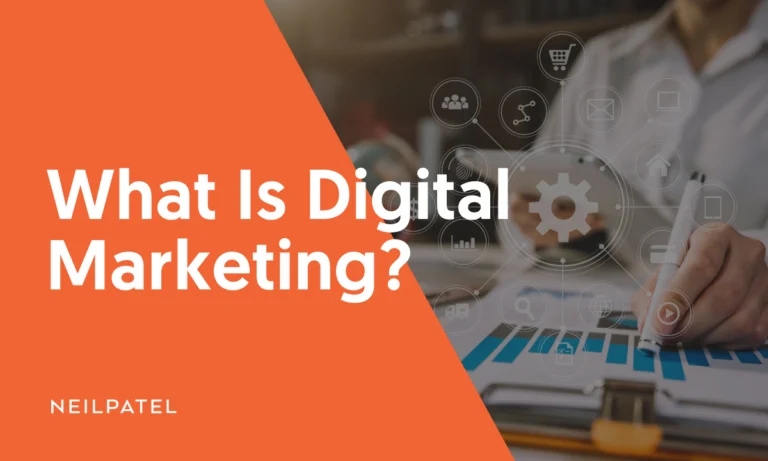
What is digital marketing, and why does it matter? That’s precisely what I plan to discuss today.
Digital marketing means using digital channels, like search engines, social media, email, mobile apps, and websites, to promote a product or service. This umbrella term also includes marketing using digital devices such as TV or radio.
Examples of online digital marketing include:
- Search engine optimization (SEO): optimizing a website to improve its visibility and ranking on search engines like Google.
- Pay-per-click advertising (PPC): paying for advertisements to appear on search engine results pages or social media platforms.
- Social media marketing: creating and sharing content on social media platforms like Facebook, Twitter, and Instagram to increase brand awareness and engagement.
- Content marketing: creating and sharing valuable content, such as blog posts, e-books, or videos, thus attracting and retaining a specific audience.
- Leveraging traditional offline media for advertising: using radio and TV marketing, billboard advertising, print, and in-person events.
Analysts predict the global digital advertising and marketing sector will reach $786.2 billion by 2026, with clicks and display ads among the most dominant forms.
Then there’s offline digital marketing like:
- Out-of-Home Advertising: This involves using billboards, transit ads, or other types of visual media to promote your brand or product. This can be a great way to reach a broad audience and create a strong visual impression.
- TV Marketing: where you promote your products in the form as adverts, infomercials, or even demonstrations.
- Radio marketing: Trailers and commercials promoting your product to listeners.
In other reports by PR Newswire, digital marketing is worth an estimated $460 billion in the US.
You can do digital marketing online and offline, and using a combination is vital to any well-rounded strategy. These techniques and strategies help businesses to reach their target audience, engage with them, and ultimately convert them into customers.
This guide covers everything you need to know to get started with digital marketing, but first, let’s discuss why it’s so essential to your business.
Why Digital Marketing Matters
Remember billboards? I do.
As a young kid in California, my experiences from the back seat of our car mostly alternated between: “Mom, when are we there?” and “Uh, look, McDonald’s, can we go?” whenever one of those 10-foot billboards popped up on the side of the road.
Growing up with Indian parents, the answer to both of those would, most times, be the same: “Not yet.”
Sometimes, big brands would even start a billboard war, like this one between Audi and BMW, which got quite a few laughs:
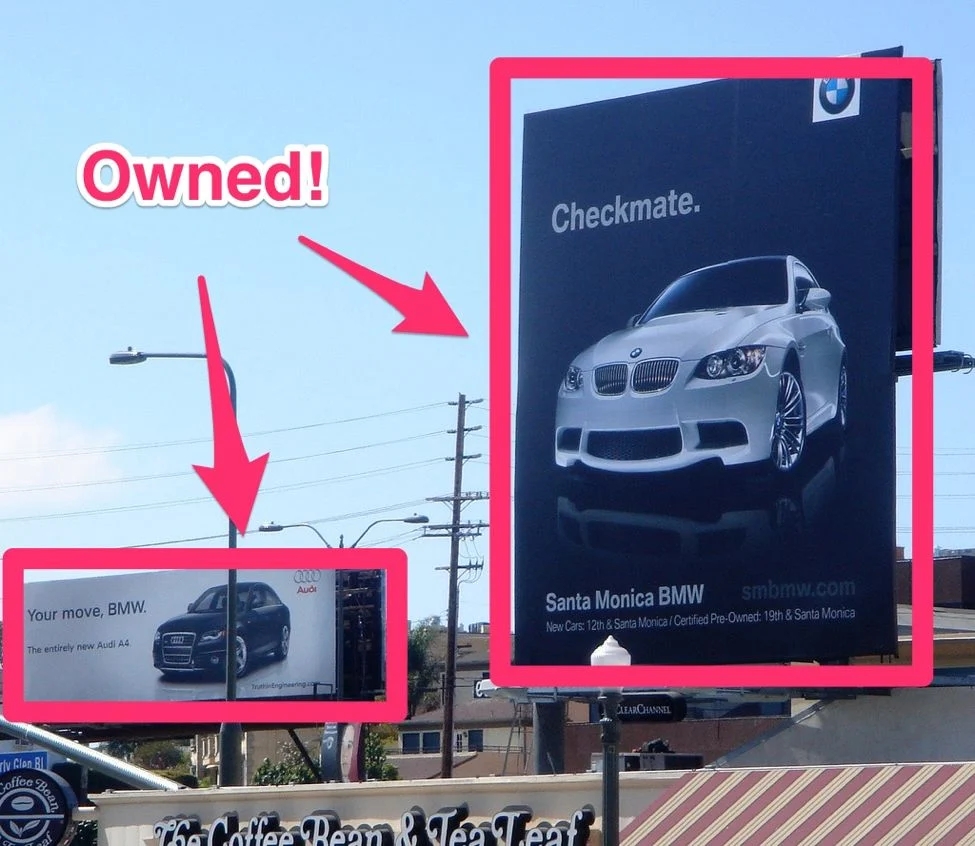
My clients spent hundreds of millions of dollars on billboard advertising not long ago. However, times have changed.
Today, most companies have moved to online (digital) marketing.
That’s because Google and Facebook generate more revenue than traditional media companies.
Then there is the use of mobile devices.
You can go just about anywhere these days. Whether you are at the grocery store, a restaurant, or even a movie theater, they have one thing in common: you’ll see plenty of people with their eyes practically glued to their phones.
Phone advertisements are like mini billboards, broadcasting adverts whenever we look something up.
Mobile usage is massive, and the figures are only heading upward.
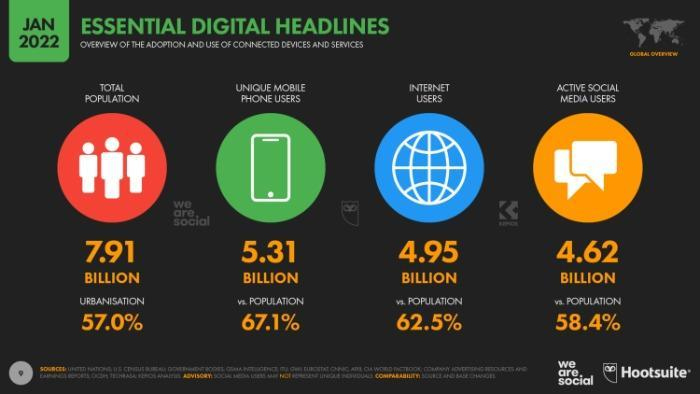
There are 5.31 billion mobile phone users worldwide, 4.95 billion internet users, and 4.62 billion social media users.
Moreover, the share of people spending more time using electronic devices continues to rise while print advertising declines.
The stats are clear.
Digital marketing isn’t optional if you want to get your product/services in front of customers; your customers are online, and you must be there too.
And don’t go thinking digital marketing is just for the big corps.
Even the smallest local stores can benefit from some form of online advertising. According to Google, 88 percent of people who conduct a local search on their smartphone visit a related store in the next week.
All of this, and I haven’t even gotten to some of the best things about digital marketing. It:
- Provides access to more data: you get access to vital analytics about your customers, how they navigate the buying cycle, and what they want. You can use this data to analyze what works and doesn’t and tailor your strategy accordingly.
- Helps you reach a wider audience: Digital marketing allows you to reach a wider audience than traditional marketing methods. For example, social media platforms like Facebook and Twitter have billions of active users, and advertising can help you target demographics. By 2027, social network users will reach almost six billion. So it’s a platform you can’t ignore.
- Is cost-effective: Digital marketing is more affordable than traditional marketing methods like TV or print advertising. With digital marketing, you can create highly targeted campaigns with a better return on investment (ROI) for your business and reach your goals.
- Provides greater engagement: Digital marketing allows for greater engagement with your target audience. You can use email, social media, and content marketing tactics to keep your audience engaged and interested in your products and services. For instance, creating a blog with valuable content on your website can attract visitors and make them more likely to buy. According to HubSpot, 56 percent of people who read a blog post go on to purchase.
- Offers measurable results: With digital marketing, you can track and measure the effectiveness of your campaigns. You can use tools like Ubersuggest and Google Analytics to analyze web traffic, conversion rates, and other metrics to see your campaigns’ performance.
- Helps your business stay competitive: A digital marketing strategy is essential in today’s digital age. Your competitors are likely using digital marketing to reach their target audience, so you don’t want to fall behind. For instance, email marketing offers the highest ROI compared with other digital marketing strategies.
These are just some examples of why digital marketing is important. By combining digital marketing tactics, you can improve your visibility, engage with your target audience, and drive revenue for your business.
The History of Digital Marketing
Digital marketing first became popular in the early 2000s, but it’s been around much longer.
Like, WAY longer. About 100 years longer, to be exact.
Here’s a pic of the first digital marketer in history:
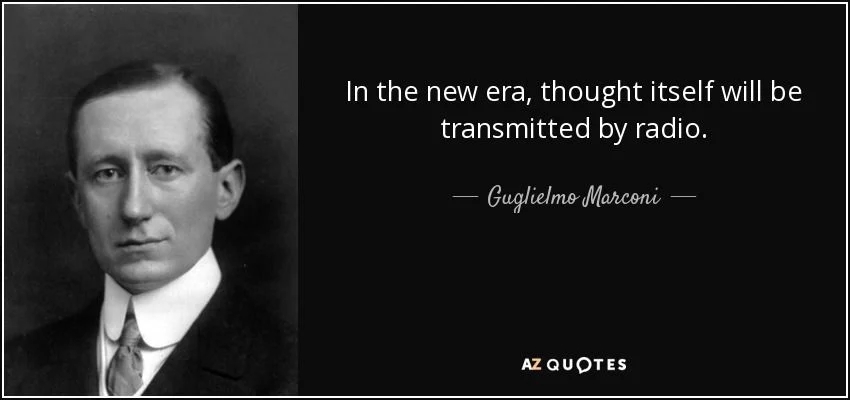
His name was Guglielmo Marconi, and he was born in 1874.
In 1896, Marconi became the first human to demonstrate a “public transmission of wireless signals” when he invented the radio.
While it would take another ten years for the radio to reach the general public, it sure didn’t take the creators long to realize they could use it to sell stuff.
The first live broadcast was from an opera performance at the Met, and guess what people did after it?
They bought show tickets!
Digital marketing was born.
Online Digital Marketing Overview
The two main pillars of digital marketing are online and offline. That said, since I’ll talk about online marketing in a separate guide, I’ll only mention the different areas of online marketing here for completeness.
The seven big categories of online marketing are:
- Search engine optimization (SEO)
- Search engine marketing (SEM)
- Content marketing
- Social Media Marketing (SMM)
- Pay-per-click advertising (PPC)
- Affiliate marketing
- Email marketing
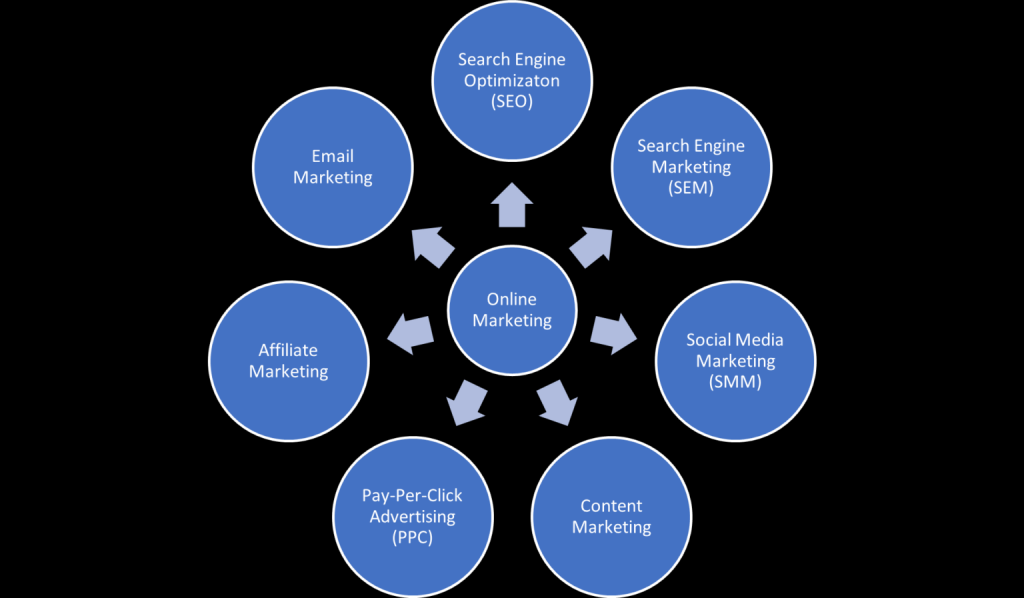
Intro to Offline Digital Marketing
There are five main categories of offline digital marketing:
- Enhanced offline marketing
- Radio marketing
- Television marketing
- Phone marketing
- QR codes
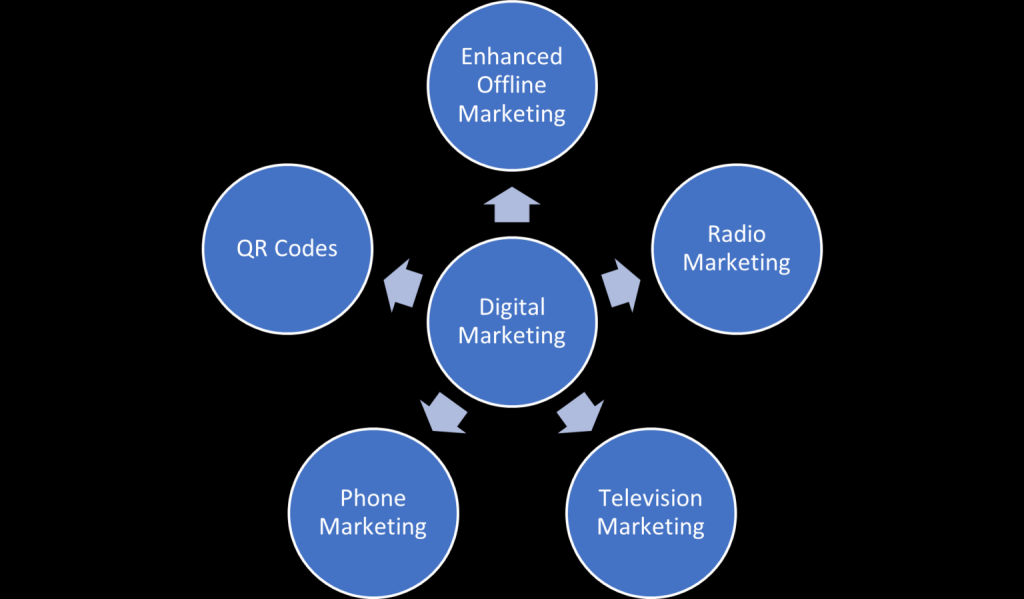
As the name suggests, enhanced offline marketing is performed solely offline. It integrates traditional offline marketing methods like direct mail, TV, radio ads, billboards, or event marketing.
First, let’s look at an example of enhanced offline marketing in action. Let’s say your restaurant uses iPads for your customers to place orders. In that case, the offline experience of eating Thai food is enhanced with this electronic device.
Next, there’s radio marketing. So the next time you hear an annoying, over-enthusiastic car dealer shout every word of their commercial, thank Mr. Marconi.
Of course, we can’t forget television marketing. Although streaming is hugely popular, traditional TV advertising still has its part. Statistics show revenues from TV advertising reached 171 billion in 2022.
Although phone marketing might seem old-fashioned, 102 call centers opened in the United States in 2021, and call centers made an annual revenue of $21.2 million.
Enhanced Offline Marketing
What’s the difference between a billboard in the desert of Arizona and a billboard in New York City’s Times Square?
The size? The product?
Three letters: LED. Light emitting diodes.
All of the billboards in Times Square are electronic!

Credit: NICOLAS ECONOMOU / GETTY IMAGES
Why? Because in the desert of Arizona, no one’s competing with you for people’s attention. If you have a billboard at all, you win.
In Times Square, attention is probably more valuable than anywhere else in the world, with more than 360,000 visitors daily.
With a constant flow of buses, taxis, promoters shouting, and electronic billboards, there are distractions everywhere you go. Some of the billboards are even interactive, showing live feeds of the people on the square or pictures of customers.
Here’s another example.
What do you see when you walk into an Apple Store these days?
People leaning over iPads, Macbooks, and iPhones.
Product demos should be an essential part of your digital marketing strategy if you have any type of electronic product.
Another example is those free trial CDs that AOL sent out in the early 90s—you may remember those were everywhere at one point. All those CDs may have been annoying, but they’re likely a big reason for AOL’s early success.
Radio Marketing
The radio isn’t dead. It’s thriving: Just look at the stats:
- 83 percent of Americans listen to radio weekly.
- People spend an average of 99 minutes per day listening to radio content.
- Revenue from radio is predicted to reach 35.33 billion in 2023.
For brands, radio can be a smart move for offline digital marketing. These days, hosts read out advertising sponsorships at the beginning of shows when they’re more likely to get listeners’ attention.
If this is an approach you’re considering, find your local radio stations with a quick Google search. Look for a station whose audience reflects your company’s target demographic; radio stations should provide the data that helps you select the right fit.
For example, if your company sells maternity products, search for a radio program whose average listener is a female between 24 and 40.
If you go the traditional radio advertising route, the key is to be entertaining and catch the listener’s attention.
Here are some tips for creating a great advert for traditional radio:
- Keep it brief and memorable: Radio ads are generally short, typically 30 seconds or less, so focus on delivering your message clearly, concisely, and in a memorable way. Use simple language and a clear call to action.
- Focus on your audience: Understand your target audience and tailor your message to their needs and interests. Use language and tone that resonates with them, and highlight the benefits of your product or service.
- Use sound creatively: Since you can’t rely on visuals, use sound to capture the listener’s attention and make an emotional connection. For example, consider using music, sound effects, or voiceovers to create a sense of atmosphere or reinforce your message.
- Repeat your message: Repetition is critical in radio advertising. Repeat your brand name and message multiple times to ensure it sticks in the listener’s memory.
- Measure your results: Use tools like unique landing pages or promo codes to track the effectiveness of your radio ads and adjust your strategy accordingly.
Overall, the key to creating an effective radio ad is to create a memorable message that resonates with your target audience and stands out from the crowd.
Cadillac and Dairy Queen are two brands that consistently produce solid radio commercials.
You can listen to some examples here.
TV Marketing
While streaming services like Netflix and Amazon Prime seem to dominate, television marketing is still huge and unlikely to disappear fully.
Here are some fast facts about TV marketing:
- 123.8 million households in the US have a television.
- Cord-cutting households (those ditching cable) are expected to reach 46.6 million in 2024.
- Eighty-seven percent of US households have at least one streaming service.
However, targeting the right audience with cable TV ads is more challenging. They typically have a low ROI compared to other forms of digital advertising and generally seem irrelevant in the digital age.
That said, one type of television ad may still be worth it, but it costs you big time.
A 30-second commercial aired during the Super Bowl costs $7 million.
The often viral and memorable commercials still pay for themselves thanks to their cross-pollinating effect. These days, social media complements in-game advertising, creating buzz long after the ads have played on screen.
If your commercial makes it to the blacklist (commercials the network decides aren’t suitable for TV), the viral effect is usually even more significant, like the infamous (and banned) Carl’s Junior ad that couldn’t be shown in the 2015 Super Bowl.
Moreover, these commercials become online assets, generating millions of YouTube views over time.
Sadly, the hype of the Super Bowl commercials is probably more of a remnant from a success period that’s about to fade.
Therefore, the $27 billion companies spend annually worldwide on TV commercials may not always be the best investment for your business. Television advertising is changing to make way for more custom-tailored experiences.
If you plan on doing offline digital marketing, I suggest focusing on a marketing platform or channel of the future—which, in the case of television marketing, means streaming services.
Phone Marketing
There’s no denying it. Mobile marketing is where it’s at.
Nearly 81.60 percent of Americans own a smartphone, and more people access the internet from their phones than via a desktop PC or laptop.
90 percent of people prefer to receive texts from businesses instead of phone calls. Why? Because it’s convenient and respectful of your customers’ time. It also means you can leverage many opportunities for marketing and promotion offers.
Mobile marketing is here to stay and on course to grow to 399.6 billion next year.
Let’s look at offline ways to market your products using phone marketing.
Calling and Texting
Cold calling means calling someone without prior contact to make a sale.
Despite technological advances, cold calling remains a marketing technique—with an average success rate of two percent. Although it’s a valid tactic for some sectors, it lacks the scalability of social media or email.
What works better is SMS marketing.
With a 98 percent open rate, a text message is almost a guaranteed read.
While you should get permission first, for example, by having your customers text a certain word to a phone number, several providers offer text marketing at scale.
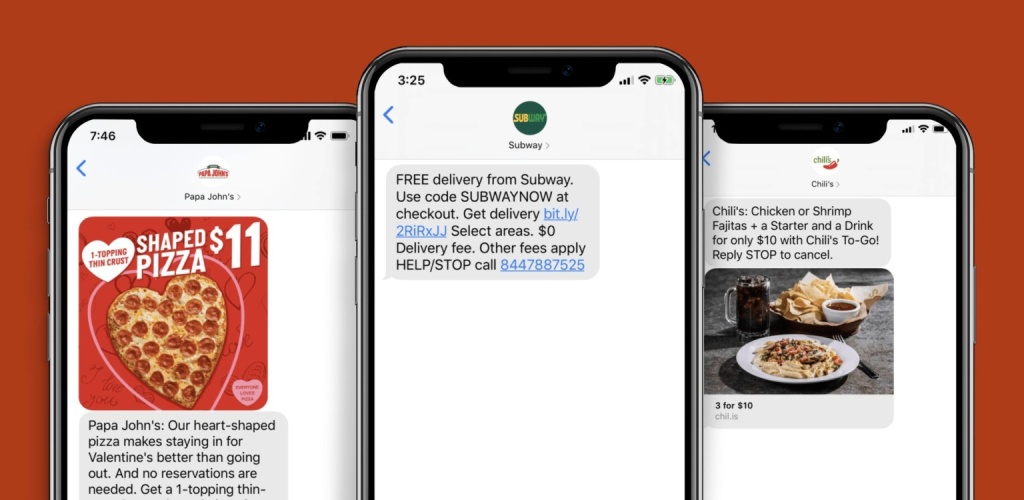
There are several ways to leverage text message marketing:
- Special deals, coupons, and discounts are great for restaurants to get additional customers and turn walk-ins into regulars. Here are some more examples of Tatango’s successful restaurant text messaging campaigns.
- Using text reminders as customer service can enhance your mobile marketing. For instance, many pharmacies alert customers when their prescription is ready for pickup.
- Another option is a loyalty program where you text participating customers special deals and giveaways